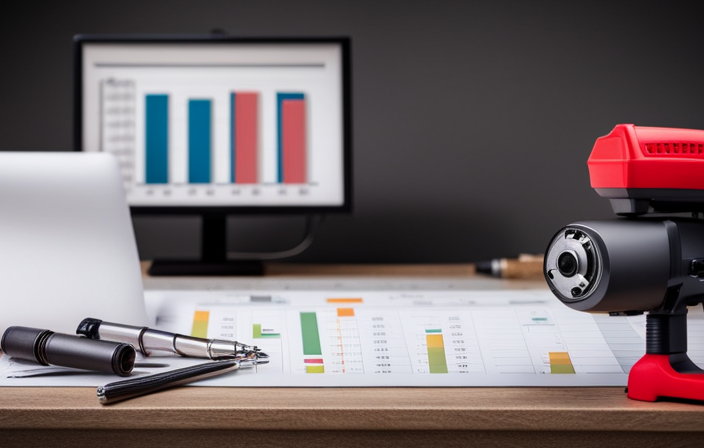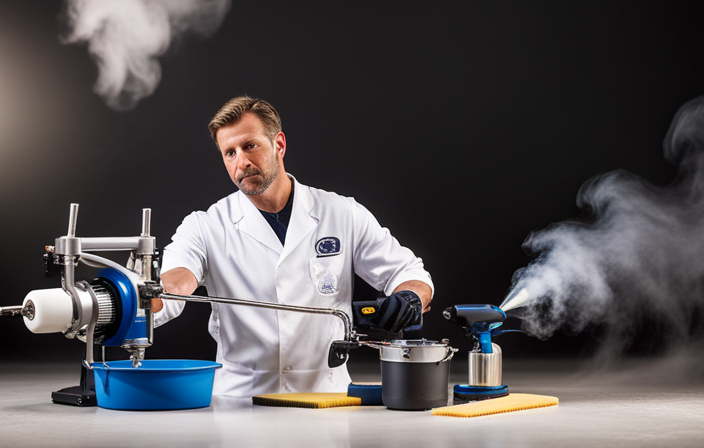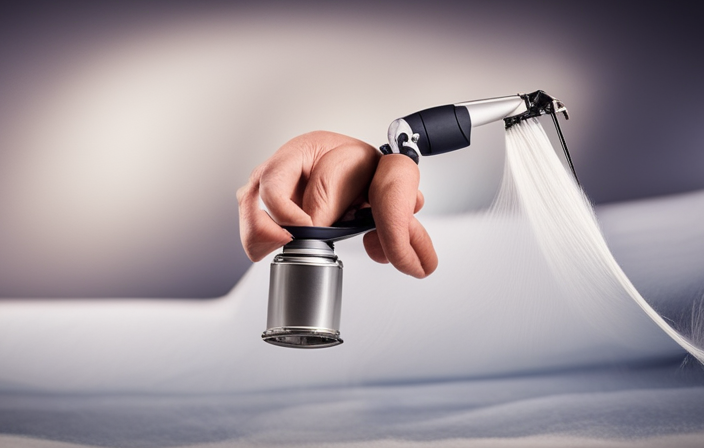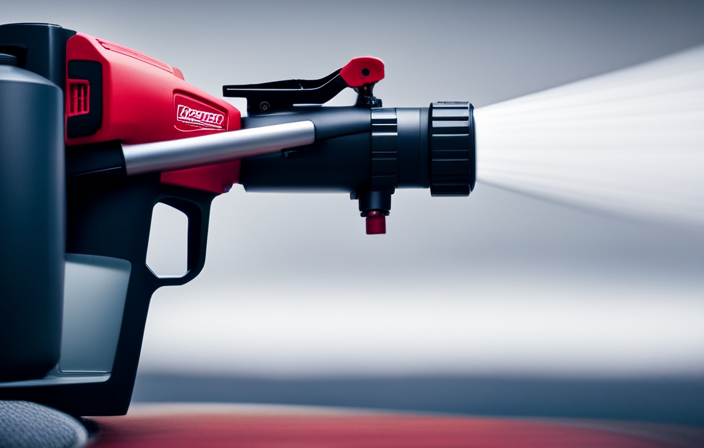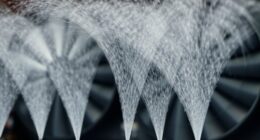Choosing the right nozzle size for your airless paint sprayer can be a daunting task. It requires a combination of expertise, hands-on experience, and careful attention to detail. But fear not, as I am here to guide you through this process with expertise and knowledge. In this article, I will clarify any confusion surrounding nozzle sizes and give you the vital information necessary to make an informed decision.
Understanding the basics of tip sizes is crucial. Factors such as the type of paint you’re using, the surface you’re painting, and the project requirements all come into play. It’s also essential to consult the manufacturer’s recommendations and consider the pressure setting. Seeking professional advice can provide valuable insights, ensuring a flawless finish.
So, let’s dive into the intricate world of tip sizes and discover the secrets that will elevate your painting endeavors to new heights. With a little practice and experience, you’ll soon be confidently wielding your airless paint sprayer like a seasoned professional.
Key Takeaways
- Tip size determines the spray fan width and should be chosen based on the surface size and the type of paint being used.
- Flow rate, measured in gallons per minute (GPM), is important and should be considered when selecting the nozzle size.
- Adjusting the pressure setting on the sprayer is crucial to avoid overspray or a poor quality finish.
- Seeking professional advice and guidance is highly recommended to ensure the best results and to consider factors such as surface type, paint viscosity, and desired finish.
Understanding the Basics of Tip Sizes
To confidently choose the right tip size for your airless paint sprayer and achieve stunning results, it is important to understand the basics of tip sizes. This includes recognizing the significance of tip sizes in achieving the desired spray pattern and coverage. When selecting a tip size, several factors should be taken into consideration. These factors include the type of paint being used, the surface being painted, and the desired finish. Thicker paints, such as primers or textured coatings, require larger tip sizes to accommodate their higher viscosity. Conversely, thinner paints, like stains or lacquers, work best with smaller tip sizes. The surface texture and desired finish, whether smooth or textured, also influence the appropriate tip size. It is advisable to consider the type of paint being used to further narrow down the choices and optimize the spraying experience.
Consider the Type of Paint You’re Using
When deciding on the appropriate nozzle for your airless paint sprayer, take into account the specific type of paint you’re working with to ensure optimal results. Different types of paint require different tip sizes to achieve the best coverage and finish.
Here are some considerations to keep in mind:
-
Type of Primer: If you’re using a primer before applying the paint, consider its viscosity and thickness. Some primers may require a larger tip size to accommodate their thicker consistency.
-
Latex Paint: Latex or water-based paints typically work well with smaller tip sizes, such as 0.015 to 0.019 inches. These paints have a lower viscosity and can be sprayed effectively with finer tips.
-
Oil-based Paint: Oil-based paints, on the other hand, are thicker and require larger tip sizes, such as 0.021 to 0.025 inches. These tips allow for better atomization and smoother application.
-
Specialty Paints: If you’re using specialty paints like textured coatings or elastomeric paints, consult the manufacturer’s guidelines for the recommended tip size.
Considering the type of paint you’re using is crucial in determining the appropriate tip size for your airless paint sprayer. Once you have this information, you can move on to determining the surface you’re painting.
Determine the Surface You’re Painting
When determining the surface I’m painting, I consider whether it’s smooth or textured. Smooth surfaces require a different approach than textured surfaces because the paint may not adhere as well to a textured surface.
Additionally, I take into account whether the surface is vertical or horizontal. Vertical surfaces may require a different technique to avoid drips and runs, while horizontal surfaces allow for easier and more even application of the paint.
Understanding these key points helps me choose the right tools and techniques for a successful paint job.
Smooth Surfaces vs. Textured Surfaces
When it comes to achieving flawless results on different surfaces, it’s crucial to consider the appropriate tip size for your airless paint sprayer. For smooth surfaces, using a smaller tip size is recommended. This allows for better control and precision, ensuring even coverage and a professional finish.
On the other hand, when painting rough or textured surfaces, a larger tip size is more suitable. The wider spray pattern provided by a larger tip size helps to fill in the grooves and uneven areas, achieving optimal coverage.
It’s important to note that using the wrong tip size can result in streaks, drips, or an uneven finish. So, always take into account the surface you’re painting and choose the appropriate tip size accordingly.
Now, let’s move on to the next section about vertical surfaces vs. horizontal surfaces.
Vertical Surfaces vs. Horizontal Surfaces
To achieve a flawless finish on vertical and horizontal surfaces, it’s important to consider the differences between them.
When it comes to spray painting, the orientation of the surface plays a crucial role in determining the appropriate tip size.
Vertical spraying requires a larger tip size compared to horizontal spraying. This is because gravity affects the paint particles differently on each surface.
With vertical surfaces, the paint needs to overcome gravity to reach the desired area, so a larger tip size is needed to ensure proper coverage.
On the other hand, horizontal surfaces allow the paint to spread more naturally, so a smaller tip size can be used.
Understanding the nuances between vertical and horizontal spraying will help you achieve optimal paint coverage on different surfaces.
Now, let’s assess the project requirements to determine the ideal tip size.
Assess the Project Requirements
Assessing the project requirements will help you determine the tip size to use on your airless paint sprayer. Here are four key factors to consider:
-
Surface Type: Different tip sizes are suitable for different types of surfaces. For example, a smaller tip size may be appropriate for spraying on smooth surfaces like drywall, while a larger tip size may be needed for rough or textured surfaces like stucco.
-
Paint Type: The type of paint you are using also influences the tip size. Thicker paints, such as latex or elastomeric coatings, generally require a larger tip size to ensure proper coverage and prevent clogging.
-
Coverage Area: The size of the area you need to cover plays a role in determining the ideal tip size. Larger projects may benefit from using a larger tip size to speed up the painting process.
-
Project Budget and Safety: Considering cost and safety precautions is important. Smaller tip sizes tend to use less paint and produce a finer finish, but they may take longer to complete the project. On the other hand, larger tip sizes can cover more area quickly, but may result in overspray and waste more paint.
Assessing these project requirements will help you choose the most suitable tip size for your airless paint sprayer. Once you have determined the appropriate tip size, it is essential to consult the manufacturer’s recommendations for additional guidance.
Consult the Manufacturer’s Recommendations
After assessing the project requirements, the next step is to consult the manufacturer’s recommendations for the airless paint sprayer.
This is an important step because the manufacturer knows their product best and can provide valuable insights on the appropriate tip size to use. They have conducted extensive testing and research to determine the optimal tip size for different types of projects.
It’s always a good idea to follow the manufacturer’s recommendations to ensure the best results and avoid any potential issues.
Additionally, seeking professional advice from experts in the field can also be helpful. They can provide personalized recommendations based on their experience and expertise.
By considering both the manufacturer’s recommendations and professional advice, you can make an informed decision on the tip size to use for your airless paint sprayer.
Now, let’s move on to the next section and discuss how to test and adjust the spray pattern.
Test and Adjust
When it comes to using an airless paint sprayer, it’s important to test and adjust two key factors: the spray pattern and the flow rate.
The spray pattern refers to the shape and size of the paint droplets being sprayed, which can greatly impact the overall finish of your project.
Adjusting the flow rate allows you to control the amount of paint being sprayed, ensuring proper coverage without wasting excess paint.
By testing and adjusting these factors, you can achieve a professional-looking paint job with your airless paint sprayer.
Spray Pattern
To achieve the perfect spray pattern, it’s crucial to determine the right tip size for your airless paint sprayer. The spray pattern refers to how the paint is distributed on the surface, and it greatly affects the final result. Here are three important factors to consider when determining the right tip size:
-
Spray coverage: The tip size determines the width of the spray fan. A smaller tip size will result in a narrower spray fan, while a larger tip size will create a wider fan. Consider the size of the surface you’re painting and choose a tip size that will provide adequate coverage.
-
Paint thickness: Different paints have different viscosities, or thicknesses. The tip size should be chosen based on the type of paint you’re using. Thicker paints require larger tip sizes to ensure proper atomization and even coverage.
-
Surface texture: The texture of the surface also affects the spray pattern. Rough surfaces require larger tip sizes to ensure that the paint reaches all the crevices and uneven areas.
Determining the right tip size will help you achieve a flawless spray pattern and optimal results.
Moving on to the next section, let’s talk about the importance of flow rate in airless paint sprayers.
Flow Rate
As we discussed earlier, the spray pattern is an important factor to consider when using an airless paint sprayer. Now, let’s move on to another crucial aspect: flow rate. The flow rate refers to the amount of paint that is delivered by the sprayer in a given time. It is measured in gallons per minute (GPM) and determines how quickly you can cover an area. To select the right flow rate for your project, you need to consider the size of the surface you are painting and the type of paint you are using. A higher flow rate is suitable for larger surfaces, while a lower flow rate is ideal for smaller areas. Additionally, the flow rate also affects the nozzle selection. Different flow rates require different nozzle sizes to achieve the desired spray pattern. Now, let’s move on to the next section and consider the pressure setting for your airless paint sprayer.
Consider the Pressure Setting
To determine the appropriate tip size to use, start by adjusting the pressure setting on your airless paint sprayer. The pressure range of your sprayer is crucial in achieving the desired results.
If the pressure is too high, it can cause overspray and create an uneven finish. Conversely, if the pressure is too low, the paint may not atomize properly, resulting in a poor quality finish.
Consider the nozzle compatibility with the pressure setting as well. Different tip sizes are designed to handle specific pressure ranges. Therefore, it’s important to ensure that your chosen tip size is compatible with the pressure setting you have adjusted.
Keep in mind that seeking professional advice is always a wise step to take, especially if you are unsure about the appropriate tip size for your specific project.
Seek Professional Advice
Consider consulting with a professional for expert guidance and ensure a flawless finish for your project.
They have the knowledge and experience to help you determine the right tip size for your airless paint sprayer.
A professional can assess the specific requirements of your project, taking into account factors such as the type of surface, the paint viscosity, and the desired finish.
They can also provide alternative methods if needed, such as adjusting the pressure settings or using different tips for different areas.
Professional guidance is invaluable when it comes to achieving the best results with your airless paint sprayer.
Once you have the right tip size, it’s important to follow the necessary safety precautions to protect yourself and others.
Safety Precautions
To ensure a safe working environment, it is important to follow necessary precautions when using an airless paint sprayer. Two key safety measures to consider are respirator usage and proper ventilation. When working with paint sprayers, it is crucial to protect your respiratory system by wearing a respirator. This will help filter out any harmful particles or fumes that may be released during the painting process. Additionally, proper ventilation is essential to maintain a healthy workspace. Adequate airflow will help dissipate any paint vapors and prevent the accumulation of hazardous substances in the air. To ensure you are using the correct tip size on your airless paint sprayer, it is important to practice and gain experience. Understanding the different tip sizes and their applications will help you achieve the desired results in your painting projects.
Practice and Experience
Gaining experience and practicing with an airless paint sprayer is essential for achieving optimal results in your painting projects. When it comes to using the right tip size on an airless paint sprayer, practice techniques and troubleshooting tips can be incredibly helpful.
Here are some key points to keep in mind:
- Start with a smaller tip size and gradually increase it until you achieve the desired spray pattern and coverage.
- Experiment with different tip sizes to find the one that works best for the specific paint and surface you are working on.
- Pay attention to the manufacturer’s recommendations and guidelines for tip sizes.
By practicing and gaining experience, you will become more familiar with the different tip sizes and their effects on the paint spraying process. This will allow you to make informed decisions and achieve professional-quality results in your painting projects.
Frequently Asked Questions
Can I use the same tip size for all types of paint?
Yes, the tip size should be adjusted based on the type of paint being used. For example, when using a thicker paint like latex, a larger tip size such as 0.017 to 0.021 inches is recommended for optimal paint finish quality.
How do I know if the surface I’m painting requires a specific tip size?
Choosing the right tip size for an airless paint sprayer can greatly impact the quality and efficiency of your painting project. Factors to consider include the material being sprayed, surface texture, project requirements, manufacturer’s recommendations, and conducting a test spray. Seek professional advice if unsure.
What are some common project requirements that may affect the tip size I should use?
When considering common project requirements that affect tip size selection, factors like the type of surface, desired finish, and paint viscosity come into play. These elements determine the appropriate tip size for achieving the best results.
Are there any safety precautions I should take when using an airless paint sprayer?
When using an airless paint sprayer, it is important to take precautions for safety. This includes wearing protective gear, properly ventilating the area, and avoiding contact with the paint. Additionally, selecting the right tip size is crucial for achieving the desired finish and avoiding clogs.
What are some signs that indicate I may need to seek professional advice regarding tip size selection for my airless paint sprayer?
When it comes to seeking professional advice for tip size selection on your airless paint sprayer, there are a few indicators to look out for. These include inconsistent spray patterns, excessive overspray, and difficulty in achieving desired coverage.
Conclusion
In conclusion, it is crucial to choose the right tip size for your airless paint sprayer in order to achieve the desired results. By considering factors such as the type of paint, surface, project requirements, and manufacturer’s recommendations, you can make an informed decision.
Did you know that using the wrong tip size can result in uneven coverage and wasted paint? Imagine spending hours painting a room only to realize that the finish is patchy and you need to start over.
Avoid this frustration by understanding the importance of tip size selection and following the appropriate guidelines.



